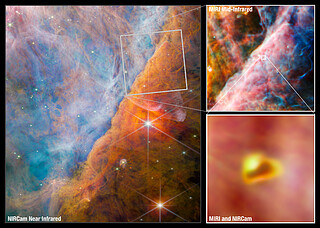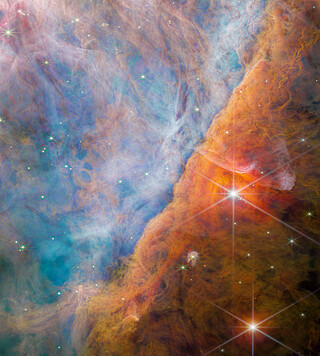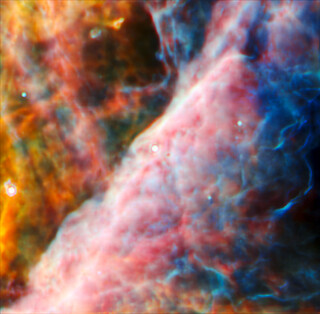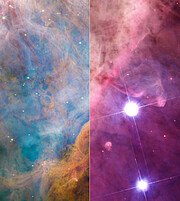weic2315 — Science Release
Webb makes first detection of crucial carbon molecule in a planet-forming disc
26 June 2023
An international team of scientists have used data collected by the NASA/ESA/CSA James Webb Space Telescope to detect a molecule [1] known as the methyl cation (CH3+) for the first time, located in the protoplanetary disc surrounding a young star. They accomplished this feat with a cross-disciplinary expert analysis, including key input from laboratory spectroscopists. This simple molecule has a unique property: it reacts relatively inefficiently with the most abundant element in our Universe (hydrogen) but reacts readily with other molecules and therefore initiates the growth of more complex carbon-based molecules. Carbon chemistry is of particular interest to astronomers because all known life is carbon-based. The vital role of CH3+ in interstellar carbon chemistry was predicted in the 1970s, but Webb’s unique capabilities have finally made observing it possible — in a region of space where planets capable of accommodating life could eventually form.
Carbon compounds [2] form the foundations of all known life, and as such are of a particular interest to scientists working to understand both how life developed on Earth, and how it could potentially develop elsewhere in our Universe. As such, interstellar organic chemistry [3] is an area of keen fascination to astronomers who study the places where new stars and planets form. Molecular ions [4] containing carbon are especially important, because they react with other small molecules to form more complex organic compounds even at low interstellar temperatures [5]. The methyl cation (CH3+) is one such carbon-based ion. CH3+ has been posited by scientists to be of particular importance since the 1970s and 1980s. This is due to a fascinating property of CH3+, which is that it reacts with a wide range of other molecules. This little cation is significant enough that it has been theorised to be the cornerstone of interstellar organic chemistry, yet until now it has never been detected. The unique properties of the James Webb Space Telescope made it the ideal instrument to search for this crucial cation — and already, a group of international scientists have observed it with Webb for the first time. Marie-Aline Martin of Paris-Saclay University, France, a spectroscopist and science team member, explains: “This detection of CH3+ not only validates the incredible sensitivity of James Webb but also confirms the postulated central importance of CH3+ in interstellar chemistry.”
The CH3+ signal was detected in the star-protoplanetary disc [6] system known as d203-506, which is located about 1350 light years away, in the Orion Nebula. Whilst the star in d203-506 is a small red dwarf star, with a mass only about a tenth of the Sun’s, the system is bombarded by strong ultraviolet radiation from nearby hot, young, massive stars. Scientists believe that most planet-forming protoplanetary disks go through a period of such intense ultraviolet radiation, since stars tend to form in groups that often include massive, ultraviolet-producing stars. Fascinatingly, evidence from meteorites suggest that the protoplanetary disc that went on to form our Solar System was also subject to a vast amount of ultraviolet radiation — emitted by a stellar companion to our Sun that has long since died (massive stars burn brightly and die much faster than less massive stars). The confounding factor in all this is that ultraviolet radiation has long been considered to be purely destructive to the formation of complex organic molecules — and yet there is clear evidence that the only life-supporting planet that we know of was born from a disc that was heavily exposed to it.
The team that performed this research may have found the solution to this conundrum. Their work predicts that the presence of CH3+ is in fact connected to ultraviolet radiation, which provides the necessary source of energy for CH3+ to form. Furthermore, the period of ultraviolet radiation experienced by certain disks seems to have a profound impact on their chemistry. For example, Webb observations of protoplanetary disks that are not subject to intense ultraviolet radiation from a nearby source show a large abundance of water — in contrast to d203-506, where the team could not detect water at all. The lead author, Olivier Berné of the University of Toulouse, France, elaborates, “This clearly shows that ultraviolet radiation can completely change the chemistry of a proto-planetary disc. It might actually play a critical role in the early chemical stages of the origins of life by helping to produce CH3+ — something that has perhaps previously been underestimated.”
Although research published as early as the 1970s predicted the importance of CH3+, it has previously been virtually impossible to detect. Many molecules in protoplanetary discs are observed using radio telescopes. However, for this to be possible the molecules in question need to possess what is known as a ‘permanent dipole moment’, meaning that the molecule’s geometry is such that its electric charge is permanently off balance, giving the molecule a positive and a negative ‘end’. CH3+ is symmetrical, and therefore its charge is balanced, and so lacks the permanent dipole moment necessary for observations with radio telescopes. It would theoretically be possible to observe spectroscopic lines emitted by CH3+ in the infrared, but the Earth’s atmosphere makes these essentially impossible to observe from Earth. Thus, it was necessary to use a sufficiently sensitive space-based telescope that could observe signals in the infrared. Webb’s MIRI and NIRSpec instruments were perfect for the job. In fact, a CH3+ detection had previously been so elusive that when the team first saw the signal in their data, they were not sure how to identify it. Remarkably, the team were able to interpret their result within four short weeks, by drawing on the expertise of an international team with a varied range of expertise.
The discovery of CH3+ was possible only through a collaboration among observational astronomers, astrochemical modellers, theoreticians, and experimental spectroscopists, which combined the unique capabilities of JWST in space with those of Earth-based laboratories in order to successfully investigate and interpret our local universe’s composition and evolution. Marie-Aline Martin adds: “Our discovery was only made possible because astronomers, modellers, and laboratory spectroscopists joined forces to understand the unique features observed by James Webb.”
The PDRs4ALL ERS team's results have been published today in Nature.
Notes
[1] A molecule is a particle made up of two or more atoms that are held together by chemical bonds.
[2] A compound is a molecule that includes more than one element. Thus, all compounds are molecules but not all molecules are compounds. As an example, the hydrogen molecule (H2) is a molecule but not a compound, whereas the water molecule (H2O) is also a compound.
[3] Organic chemistry refers to the chemistry of carbon-based molecules and compounds. It may also be referred to as carbon chemistry.
[4] An ion is an atom or molecule that has an overall electrical charge, due to an excess or deficit in the number of negative electrons compared to the number of positive protons in the ion. A cation is an ion with a net positive charge (so a deficit of electrons).
[5] A complex organic molecule is a molecule with multiple carbon atoms.
[6] A protoplanetary disc is a rotating disc of gas and dust that forms around young stars, and from which planets can ultimately form.
More information
Image Credit: ESA/Webb, NASA, CSA, M. Zamani (ESA/Webb), the PDRs4All ERS Team
Webb is the largest, most powerful telescope ever launched into space. Under an international collaboration agreement, ESA provided the telescope’s launch service, using the Ariane 5 launch vehicle. Working with partners, ESA was responsible for the development and qualification of Ariane 5 adaptations for the Webb mission and for the procurement of the launch service by Arianespace. ESA also provided the workhorse spectrograph NIRSpec and 50% of the mid-infrared instrument MIRI, which was designed and built by a consortium of nationally funded European Institutes (The MIRI European Consortium) in partnership with JPL and the University of Arizona.
Webb is an international partnership between NASA, ESA and the Canadian Space Agency (CSA).
The international team of astronomers in this study consists of Olivier Berné (CNRS, CNES and University of Toulouse, France), Marie-Aline Martin-Drumel (Institut des Sciences Moléculaires d’Orsay - CNRS, Paris-Saclay University, France), Ilane Schroetter (CNRS, CNES and University of Toulouse, France), Javier R. Goicoechea (CSIC and Institute of Fundamental Physics, Spain), Ugo Jacovella (Institut des Sciences Moléculaires d’Orsay - CNRS, Paris-Saclay University, France), Bérenger Gans (Institut des Sciences Moléculaires d’Orsay - CNRS, Paris-Saclay University, France), Emmanuel Dartois (Institut des Sciences Moléculaires d’Orsay - CNRS, Paris-Saclay University, France), Laurent Coudert (CNRS and Paris-Saclay University, France), Edwin Bergin (University of Michigan, USA), Felipe Alarcon (University of Michigan, USA), Jan Cami (The University of Western Ontario, Canada; SETI Institute, USA), Evelyne Roueff (CNRS, the Paris Observatory and PSL University, France), John H. Black (Chalmers University of Technology, Sweden), Oskar Asvany (University of Cologne, Germany), Emilie Habart (Institut d’Astrophysique Spatiale - CNRS, Paris-Saclay University, France), Els Peeters (The University of Western Ontario, Canada; SETI Institute, USA), Amelie Canin (CNRS, CNES and University of Toulouse, France), Boris Trahin (Institut d’Astrophysique Spatiale - CNRS, Paris-Saclay University, France), Christine Joblin (CNRS, CNES and University of Toulouse, France), Sven Thorwirth (University of Cologne, Germany), Jose Cernicharo (CSIC and Institute of Fundamental Physics, Spain), Maryvonne Gerin (CNRS, the Paris Observatory and PSL University, France), Alexander Tielens (Leiden University, The Netherlands; University of Maryland, USA), Stephan Schlemmer (University of Cologne, Germany), Marion Zannese (Institut d’Astrophysique Spatiale - CNRS, Paris-Saclay University, France), Alain Abergel (Institut d’Astrophysique Spatiale - CNRS, Paris-Saclay University, France), Jeronimo Bernard-Salas (ACRI-ST and INCLASS Common Laboratory, France), Christiaan Boersma (NASA Ames Research Center, USA), Emeric Bron (CNRS, the Paris Observatory and PSL University, France), Ryan Chown (The University of Western Ontario, Canada), Sara Cuadrado (CSIC and Institute of Fundamental Physics, Spain), Daniel Dicken (Institut d’Astrophysique Spatiale - CNRS, Paris-Saclay University, France), Meriem El-Yajouri (Institut d’Astrophysique Spatiale - CNRS, Paris-Saclay University, France), Asunción Fuente (National Astronomical Observatory, Spain), Karl D. Gordon (Space Telescope Science Institute, USA), Lina Issa (University of Toulouse, France), Olga Kannavou (Institut d’Astrophysique Spatiale - CNRS, Paris-Saclay University, France), Baria Khan (The University of Western Ontario, Canada), Ozan Lacinbala (KU Leuven, Belgium), David Languignon (CNRS, the Paris Observatory and PSL University, France), Romane Le Gal (Grenoble Alpes University and Institute of Milimetre Astronomy, France), Alexandros Maragkoudakis (NASA Ames Research Center, USA), Raphael Meshaka (CNRS, the Paris Observatory and PSL University, France), Yoko Okada (University of Cologne, Germany), Takashi Onaka (Meisei University and The University of Tokyo, Japan), Sofia Pasquini (The University of Western Ontario, Canada), Marc W. Pound (University of Maryland, USA), Massimo Robberto (Space Telescope Science Institute, USA), Markus Röllig (Physikalischer Verein and Goethe University Frankfurt, Germany), Bethany Schefter (The University of Western Ontario, Canada), Thiébaut Schirmer (Institut d’Astrophysique Spatiale - CNRS, Paris-Saclay University, France; Chalmers University of Technology, Sweden), Ameek Sidhu (The University of Western Ontario, Canada), Benoit Tabone (Institut d’Astrophysique Spatiale - CNRS, Paris-Saclay University, France), Dries Van De Putte (Space Telescope Science Institute, USA), Sílvia Vicente (Institute of Astrophysics and Space Sciences, Portugal), and Mark G. Wolfire (University of Maryland, USA).
Links
- ESA Webb Seeing Farther interactive brochure
- Release on STScI website
- Release on ESA website
- Science paper
Contacts
Bethany Downer
ESA/Webb Chief Science Communications Officer
Email: [email protected]
Olivier Berné
CNRS, CNES and University of Toulouse
Email: [email protected]
Ninja Menning
ESA Newsroom and Media Relations Office
Email: [email protected]
About the Release
| Release No.: | weic2315 | |
|---|---|---|








